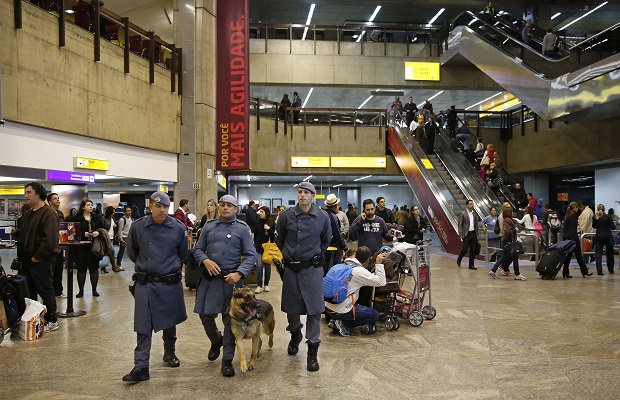
In this June 5, 2014 photo, policemen patrol at the Guarulhos International Airport, in Sao Paulo, Brazil. Only a quarter of the new $1.3 billion international terminal is operational. Many weary travelers will deplane into a poorly-lit terminal with severe concrete architecture dating from the military dictatorship of three decades ago. AP
SAO PAULO — Before they see their teams battle on the fields, soccer fans arriving in Brazil will first have to fight their way past airport scaffolding, terminal flooding and two-hour taxi lines.
The World Cup opens Thursday and airports are bracing to welcome the crush of international travelers flying in for soccer’s premier event. Brazilian authorities insist they’re ready, but passengers may find themselves in for a rough landing.
For example, officials had nearly seven years to prepare Brazil’s largest airport, Sao Paulo’s Guarulhos, yet only a quarter of the new $1.3 billion international terminal is operational. Many weary travelers will deplane into a dim terminal with severe concrete architecture dating from the military dictatorship of three decades ago.
On Monday, the wait time for a taxi at Guarulhos was more than two hours and nearby traffic was at a standstill due to a crippling strike by subway workers.
“Let’s just put it this way: We are not showing the world the best we could,” said Luiz Gustavo Fraxino, an airport infrastructure consultant in Curitiba, one of the cities hosting World Cup games.
Experts blame poor planning and excessive government control for the airport problems. A long-delayed privatization drive began too late for most upgrades to be ready.
President Dilma Rousseff has dismissed complaints that Brazil isn’t ready. The overstrained infrastructure, she says, is a sign of a nation on the move, as the middle class expands and previously poor Brazilians take to the air for the first time.
In this June 5, 2014 photo, FIFA volunteers help arriving passengers at the Guarulhos International Airport, in Sao Paulo, Brazil. Travelers who are used to stress-free arrivals, featuring clear signs in a language they understand are muddling their way through a troublesome task at Brazilian airports. For most travel in Brazil, flying is the only practical choice. The country is the size of a continent and there are no passenger rail connections, not even for the 260-mile stretch between its two largest cities, Rio de Janeiro and Sao Paulo. AP
“We aren’t building airports just for the World Cup, just for FIFA,” she recently said. “We are building for Brazilians.”
For most travel in Brazil, flying is the only practical choice. The country is the size of a continent and there are no passenger rail connections, not even for the 260-mile (418-kilometer) stretch between its two largest cities, Rio de Janeiro and Sao Paulo. To top it off, resources were stretched thin because Brazil insisted on preparing 12 cities to host the games, rather than the eight preferred by FIFA. Last week, even Rio Mayor Eduardo Paes acknowledged that decision was a mistake.
Travelers arriving in Rio will be lucky if they don’t instantly break out in a sweat. Even though it’s Brazil’s cool season, temperatures are hovering close to 80 degrees Fahrenheit (26 degrees Celsius) this week and humidity is near 70 percent. And, when it’s warm, the air conditioning tends to fail.
In Brasilia, a recent 20-minute tropical cloudburst was all it took to flood the linoleum floors of its spanking-new airport, forcing travelers to splash through the terminal. In other host cities, passengers have to walk underneath scaffolding or see brand new facilities from afar because they weren’t finished in time to be tested.
In general, comforts common to other airports, like power outlets or functional Wi-Fi, are difficult to come by. Travelers who lack Portuguese skills may have a hard time understanding local authorities, airport announcements or signage.
There can be more serious problems, too. A consumer protection agency audit at Rio’s airport earlier this year found irregularities such as blocked emergency exits, out-of-date fire extinguishers and plugged-up urinals.
Alex Lima, a safety officer on offshore oil platforms, said Rio’s airport is stretched to the max even when there’s not a major international event taking place.
“I’m here twice a month for work, so I’m immune to all the craziness,” Lima said as he waited for a flight to Sao Paulo. “But for people who’ve never been here before and are used to ‘normal’ airports, this has to be pretty shocking.”
If travelers expect problems to be smoothed over by the warm hospitality Brazilians are known for, think again.
In a reflection of the country’s dour mood, a recent Pew Research Poll said six of 10 Brazilians feel it was a bad idea to host the World Cup because it has diverted money from health care and education.
That may explain why the only evidence of festivity in Rio’s airport are a few banners that appear to have come straight from a copy center and a giant plush Fuleco, the tournament’s armadillo mascot. There are, however, plenty of porters in maroon uniforms hoping to persuade gullible tourists to illegally exchange dollars and euros for reals.
On a recent day at Sao Paolo’s airport, three young men ran around frenetically trying to find anyone who could point them to their connecting flight to Rio. A soccer fan from the Netherlands was confused when immigration officers took her passport for additional review without any explanation in English.
Christina Gubitosa, who traveled with a group of friends from Philadelphia, felt lucky to have some help.
“We are happy we are traveling with a friend who studied abroad here,” she said. “Otherwise we would be lost.”